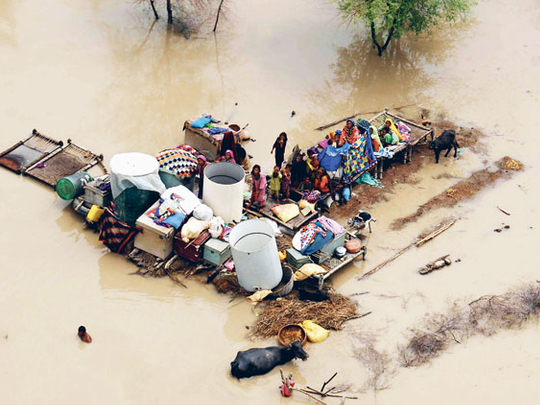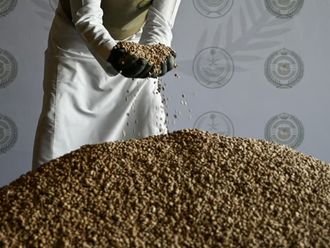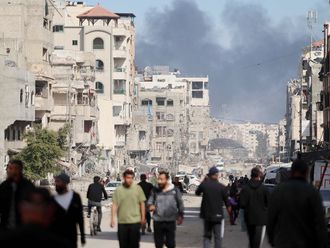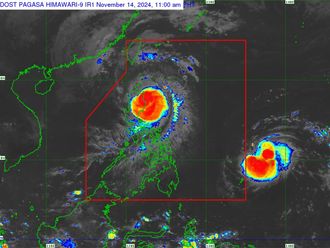
Islamabad: The number of people suffering from the massive floods in Pakistan exceeds 13 million — more than the combined total of the 2004 Indian Ocean tsunami, the 2005 Kashmir earthquake and the 2010 Haiti earthquake, the United Nations said yesterday.
The death toll in each of those three disasters was much higher than the 1,600 people killed so far in the floods that first hit Pakistan two weeks ago.
In pictures: Floods in Pakistan
But the UN estimates that 13.8 million people have been affected — over two million more than the other disasters combined.
The comparison helps frame the scale of the crisis, which the prime minister said yesterday was the worst in Pakistan's history.
It has overwhelmed the government, generating widespread anger from flood victims who have complained that aid is not reaching them quickly enough or at all.
"The number of people affected by the floods is greater than the other three disasters combined," Maurizio Giuliano, spokesman for the UN Office for the Coordination of Humanitarian Affairs, told The Associated Press.
The total number of people affected in the three other disasters is about 11 million — five million in the tsunami and three million in each of the earthquakes — said Giuliano.
Hard to assess
Pakistani Prime Minister Yousuf Raza Gilani said yesterday that the floods were a bigger crisis than the 2005 Kashmir earthquake that killed nearly 80,000 people and the army's operation against the Taliban in the Swat Valley last spring that drove more than two million people from their homes.
"The magnitude of the tragedy is so immense that it is hard to assess," said Gilani during a visit to the central Pakistani city of Multan.
Many of the people affected by the floods, which were caused by extremely heavy monsoon rains, were located in Pakistan's northwestern province of Khyber Pakhtunkhwa.
Rescue workers have been unable to reach up to 600,000 people marooned in the province's Swat Valley, where many residents were still trying to recover from last year's fight with the Taliban, said Giuliano.
Bad weather has prevented helicopters from flying to the area, which is inaccessible by ground, he said.
"All these people are in very serious need of assistance, and we are highly concerned about their situation," said Giuliano. Hundreds of thousands of people have also had to flee rising floodwaters in recent days in the central and southern provinces of Punjab and Sindh as heavy rains have continued to pound parts of the country.
One affected resident, Mansour Ahmad, said yesterday that although he managed to escape floods that submerged villages and destroyed homes in Sindh, the total lack of government help meant dying may have been a better alternative.
Death an alternative
"It would have been better if we had died in the floods as our current miserable life is much more painful," said Ahmad, who fled with his family from the town of Shikarpur and spent the night shivering in the rain that has continued to lash the country.
"It is very painful to see our people living without food and shelter," he said.
Thousands of people in the neighbouring districts of Shikarpur and Sukkur camped out on roads, bridges and railway tracks — any dry ground they could find — often with nothing more than the clothes on their backs and perhaps a plastic sheet to keep off the rain.
"We were able to escape the floodwaters, but hunger may kill us," said Hora Mai, 40, sitting on a rain-soaked road in Sukkur along with hundreds of other people.
A senior government official in Sukkur, Inam Allah Dhareejo, said authorities were working to set up relief camps in the district and deliver food to flood victims. But an Associated Press reporter who travelled widely through the worst-hit areas in Sindh over the past three days saw no sign of relief camps or government assistance.
The floods hit the country at a time when the government is already struggling with a faltering economy and a brutal war against Taliban militants that has killed thousands of people.
The US and other international partners have stepped in to support the government by donating tens of millions of dollars and providing relief supplies and assistance.
A faltering relief effort could open the door to hard-line Islamist groups, which have already been delivering aid in the northwest.
Price rises increase survivors' woes
Food prices in Pakistan are skyrocketing, compounding the misery for millions as devastating floods ravage the country's most fertile breadbasket and wipe out crops. "Roads are closed. Fields are under water and it has affected the markets badly," Amir Zada, 35, a fruit and vegetable seller in congested Pindora market told AFP in the garrison city of Rawalpindi.
Flies buzzed over unappetising collections of grapes, apricots and peaches, congealing on push carts in the market. "Orchards are under water. We are facing severe difficulties," added fruit seller Ghulam Nabi. "There are shortages with the wholesalers. Prices are up and we have no option but sell our stuff at high prices also."
Fruit, vegetables and wheat are farmed in Pakistan's rich agricultural basin along the Indus river in the central province of Punjab and Sindh to the south, as well as in the balmy plains of Khyber Pakhtunkhwa in the northwest. But for two weeks, torrential monsoon rains have devastated the country, triggering flash floods and landslides destroying 1.4 million acres of agricultural land in Punjab alone, killing off livestock and affecting 15 million people. While survivors struggle on meagre handouts of food from local elites and charities, castigating the government for not mobilising more relief faster, markets in even Pakistan's wealthiest cities are facing shortages.
"Prices have increased for every item. Vegetables are not fresh. Fruit is of poor quality," fumed housewife Shahida Begum in Rawalpindi. "I used to feed my family on Rs500 rupees (Dh21) a day. Now I'm paying more than Rs1,000 for fruit and vegetables. It's simply not affordable."
In Rawalpindi, garlic has jumped from Rs120 to Rs260 per kilogramme; tomatoes Rs40 to Rs120; green peas Rs70 to Rs130 and apricots from Rs70 to Rs150. Some shopkeepers said that relief organisations supplying dried milk to flood-hit areas had caused a shortage.
The situation was worse in Khyber Pakhtunkhwa.
"We estimate the floods have caused more than six billion rupees of losses to fertile land. Crops, vegetables and orchards have been devastated," Arbab Mohammad Ayub Jan, provincial agriculture minister, told AFP.
"This will have an extremely negative result on the markets. Prices are already high," he acknowledged.
Prices are high in areas hit by the floods, but added transportation costs are making produce even more expensive in big cities such as Peshawar, said Bashir Ahmad Bilour, senior minister in Khyber Pakhtunkhwa.In Punjab, prices were up three times while many shops and market remained closed, an AFP reporter said.
"There is no petrol in the pumps. Fruit and vegetables are less available and prices are sky high," local resident Mohammad Khaled told AFP in Kot Addu town, where much of the area has been totally flooded.












